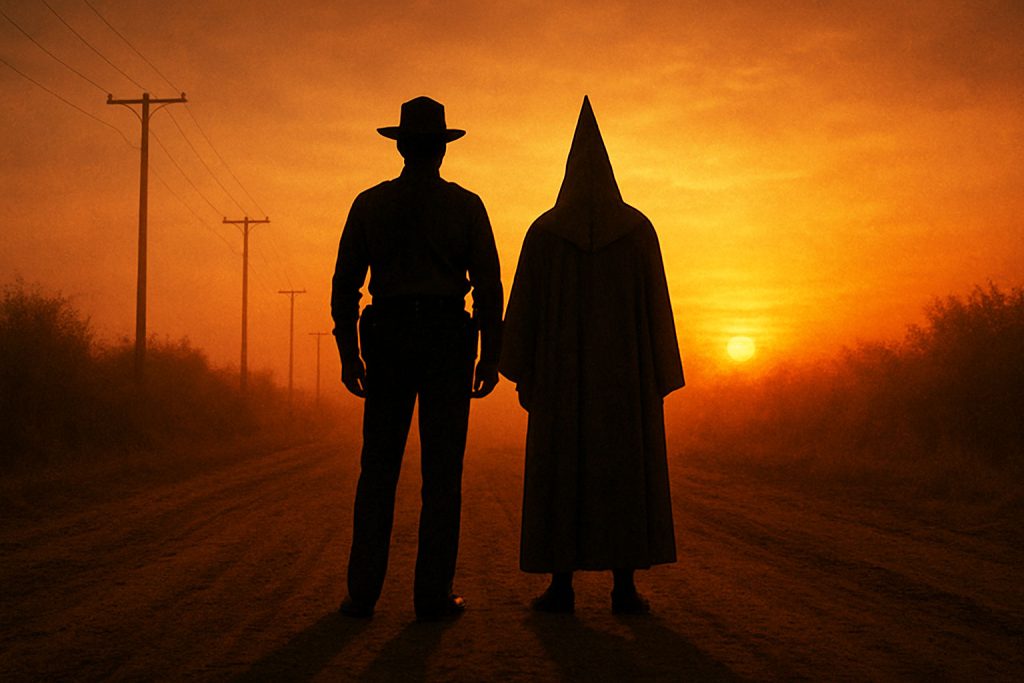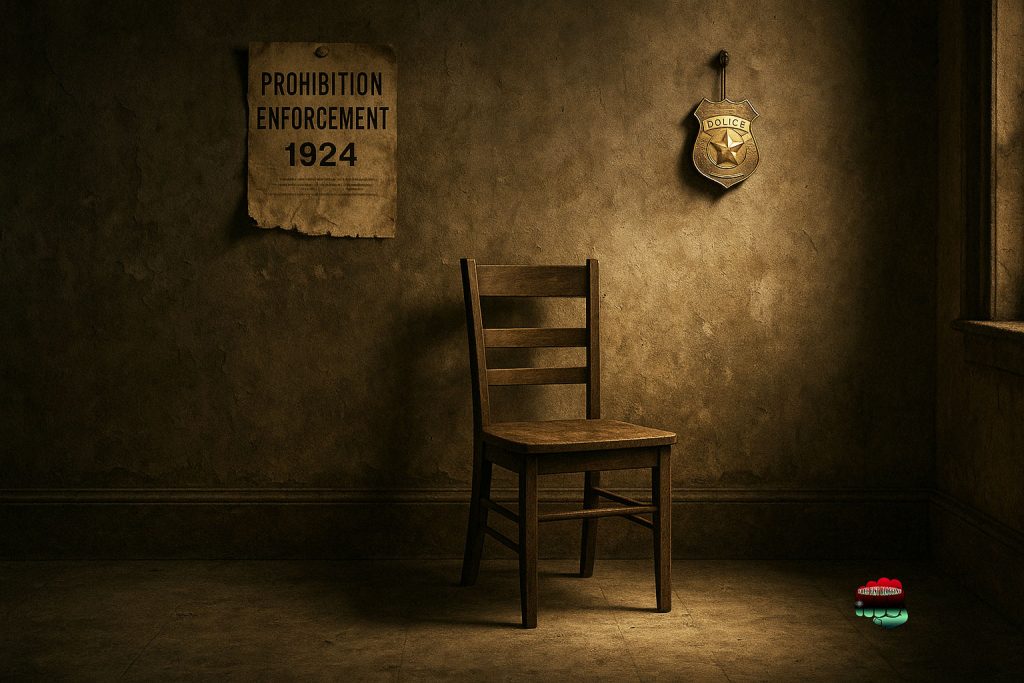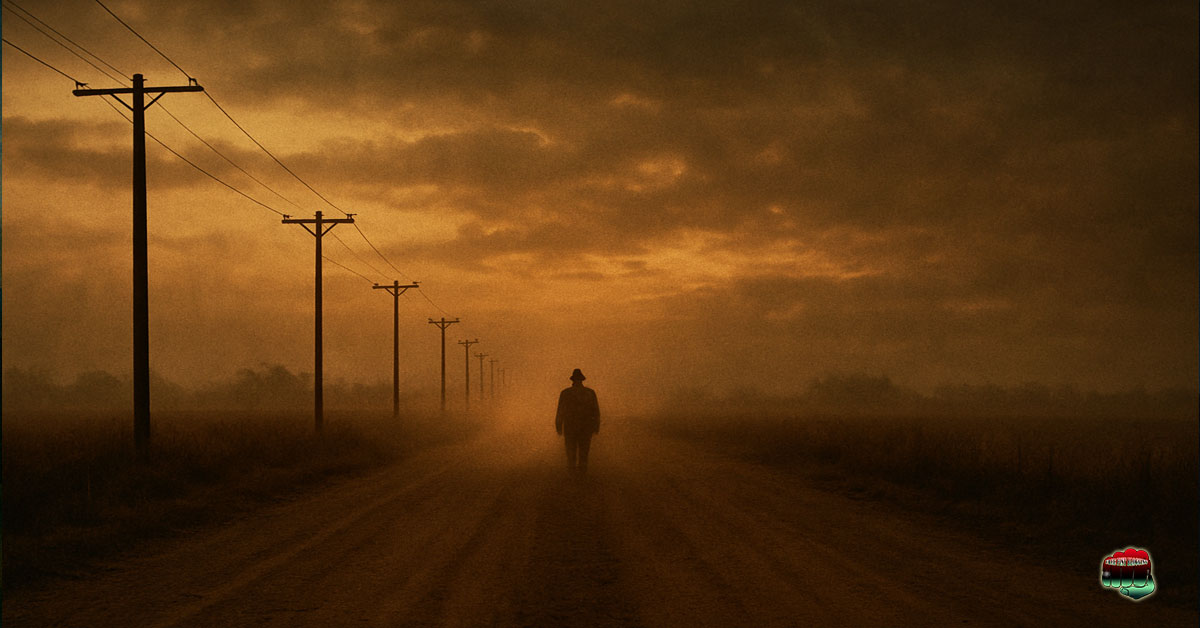Prohibition, the Klan, and the Making of America’s Racial Policing Order
By InnerKwest Editorial Desk | October 20, 2025
America tells a soft story about its institutions: that they were born flawed but earnest, stumbling toward fairness. The harder story is this—one of our most powerful institutions, modern policing, matured inside a moral panic that licensed vigilantes to behave like public servants. During Prohibition, the Ku Klux Klan did not merely lurk in the shadows of the law; it walked beside it, learned its rhythm, wore its posture, and taught it new habits of control. The hood and the badge were not the same thing. But for a crucial decade, they were close enough to leave a permanent mark.
What follows is not a museum tour of the 1920s. It is a ledger of continuities: how a nation starved of agents and swollen with zeal outsourced “order” to a movement obsessed with racial, religious, and cultural boundaries—and then absorbed the movement’s methods into the procedures of the state.
I. The Enforcement Vacuum
On January 17, 1920, the Volstead Act gave teeth to the Eighteenth Amendment. Overnight, the United States outlawed the manufacture, sale, and transport of alcohol—while devoting a meager, scattered corps of federal agents to police a continental empire of farms, towns, ports, railheads, and city neighborhoods. The arithmetic was laughable. The principle was not. Prohibition framed enforcement as a crusade: not just the suppression of contraband, but the salvation of the nation’s soul.
Crusades invite crusaders. The second Ku Klux Klan, reborn in 1915 on a Georgia mountaintop and rebranded in the early 1920s as the fraternal vanguard of “100% Americanism,” surged to a mass membership counted in the millions. It exploited the enforcement vacuum with a promise more intoxicating than whiskey: we, the righteous, will keep your streets pure. The Klan’s enemies list was familiar—Black Americans, immigrants, Catholics, Jews, labor organizers, “loose women,” anyone coded as a threat to Protestant, nativist order. Prohibition handed the Klan a legal pretext to raid spaces where those enemies gathered. The law outlawed the bottle; the Klan outlawed the people who might drink it.
In theory, federal law preempted local excess. In practice, the feds were thin on the ground, local sheriffs were thick with sympathizers, and judges were not blind. “Deputization” was rarely written on paper. It didn’t have to be. Permission wore a wink.

II. Vigilantes With a Public Address System
Klan enforcement was part theater, part terror. The theater mattered. Parades—with robes crisp, crosses unlit for daylight propriety—advertised a claim to civic guardianship. Mass initiations occupied courthouses and fairgrounds. Ministers blessed the “moral army.” When night fell, the other part commenced: roadblocks and barn torchings, still-smashing and kidnappings, whippings administered to “bootleggers,” “jezebels,” “foreign agitators,” and Black men accused of looking the wrong way at the wrong person’s daughter. Each act was narrated afterward as community defense.
Key elements made the performance effective:
- Proximity to power. In counties across Indiana, Ohio, Colorado, Alabama, Georgia, Texas, and beyond, Klan men were the power: sheriffs, deputies, constables, city councilmen, prosecutors. Even where they were not, they could count on friendly juries and cautious judges. When a mob performs enforcement for the “right reasons” in the eyes of the bench, acquittal becomes a civic ritual.
- Moral cover. Prohibition allowed the Klan to claim the mantle of law without wearing the uniform. Raiding a Black social club or an Italian tavern could be spun as a liquor operation, not an ethnic purge. Smashing a Catholic picnic (rumored to have beer) became an act of “public hygiene.”
- Press dynamics. Local newspapers, often edited by men who belonged to the same lodges as Klan officers, carried the Klan’s communiqués as if they were neighborhood bulletins. When reporters did criticize excesses, the Klan answered with spectacle and charity drives, laundering its image in civic receipts.
“You cannot train away a lineage you refuse to name.”
III. Enforcement as Exclusion
Every policing system answers the question “Whom is this for?” The Klan’s answer was explicit: the nation for white, native-born Protestants. Prohibition permitted the targeting to look neutral. In theory, any illegal drinker was a sinner. In practice, the places raided and the people punished mapped neatly onto a program of exclusion.
- Race. Black neighborhoods were treated as reservoirs of vice. A Black man found with a flask might be whipped as an example. A white man of standing was counseled in private.
- Religion. Catholic halls and parades, infused with communal feasts and beer, attracted hostile attention—and raids—under “liquor” pretexts.
- Ethnicity. Italian and Jewish proprietors of cafés, bakeries, and groceries suffered not just inspections but smash-and-seize tactics, with reputational damage that outlasted the raids.
- Labor. Union halls were surveilled; organizers were labeled “criminals” on suspicion of smuggling liquor to meetings, a versatile slur that doubled as union-busting.
The point was not sobriety; it was sorting. “Law and order” became a civil lexicon for boundary maintenance. You police vice; we police belonging.
This was not a shadow government. It was governance by shadow.
IV. The Transfer: From Mob Habit to State Procedure
This is the hinge on which the whole history swings. When the Klan overreached—when a rape scandal, a murder, or a naked graft scheme broke in the press—membership fell and political fortunes shifted. But the methods did not retreat with the robes. They seeped. They were absorbed.
Tactic-by-tactic osmosis:
- Night raids → No-knock warrants. The logic was identical: surprise is a force multiplier; the door is a technicality; shock and awe prevent “destruction of evidence.” The legal wrapping arrived later; the appetite for entry without warning belonged to an earlier culture of righteous invasion.
- Roadblocks → Stop-and-search. If a mob can halt cars on a dark road for “questions” about liquor, a uniform can do the same for “reasonable suspicion.” The terrain changes; the discretion remains unilateral.
- Parade presence → Occupation patrols. The visual grammar of a phalanx moving through a neighborhood to display authority did not die with the 1920s. It was institutionalized as a “show the flag” strategy: let them see us; let them feel watched.
- Moral charges → Catch-all statutes. “Disorderly conduct,” “vagrancy,” and later “loitering” became legal nets to capture undesirables without naming the real offense: being the wrong kind of person in the wrong kind of place.
Professionalization in the 1930s and 1940s did not disinfect these habits. It standardized them. Recruit classes inherited a craft vocabulary—“compliance,” “presence,” “control”—that allowed intrusive practices to be taught as technique. The badge did not become a hood. It didn’t have to. The badge had learned what the hood knew: who belongs, who answers questions, who is presumed dangerous, who is granted warning instead of handcuffs.
V. Courts, Unions, and the Culture of Impunity
Institutions are ecosystems. Policing does not acquire a racial hierarchy alone. It requires the symbiosis of courtrooms, city halls, union halls, and the press.
- Courts. When judges refuse to prosecute vigilantes, vigilantes become adjuncts. When later judges rationalize aggressive searches and stops as necessary for public order, they retroactively bless older instincts. The rope becomes policy; the glare becomes precedent.
- Prosecutors. Selective charging patterns teach officers whom the system protects. If beating a suspect invites no consequence but criticizing an officer does, priorities are set without a memo.
- Police fraternal orders and unions. Built to defend members’ wages and safety, many also calcified a culture of non-accountability—treating public scrutiny as betrayal. In departments with Klan lineages, the insulation covered not only good-faith error but chronic abuse—warnings without paper trails, quiet transfers, “he’s one of us.”
- Local press. The civic paper which once printed Klan proclamations as community notices learned new euphemisms. A mob was a “crowd.” A raid was an “inspection.” A beating was a “scuffle.” The citizen was a “suspect,” the corpse a “fatality,” the cause “under investigation.”
Each layer did not invent racism. Each performed a function that, in aggregate, made accountability optional and memory malleable.

VI. The Racial Ledger of “Order”
The Prohibition decade fixed a ledger logic still visible today:
- Order is moral, not merely legal. The badge is not just a tool; it is a calling. Those who resist are not merely lawbreakers; they are threats to the community’s soul. This is how a minor ordinance violation becomes a test of obedience—and how disobedience becomes an existential crime.
- Some bodies are suspicious by default. Blackness, immigrant accents, unfamiliar faiths—these become proxies for threat. The doctrine is rarely written; it is trained through anecdotes and “officer safety” lore.
- Public peace means some publics. Affluent, white neighborhoods are policed as clients to be reassured. Poor, Black, immigrant neighborhoods are policed as zones to be managed. The same badge performs two different missions.
This ledger is not folklore. It is operational. It informs where precincts are sited, where patrols concentrate, which complaints are prioritized, how force is narrated after the fact, and what reforms are deemed “unrealistic.”
From rope to regulation: the costume changed, the choreography remained
VII. Case Windows (Receipts of Continuity)
Indiana, mid-1920s. The Klan virtually owns state politics; local sheriffs coordinate with robed posses to “clean up” bootlegging while intimidating Catholics and immigrants. When the Klan’s political leader falls in scandal, the machine wobbles—but the local enforcement habits remain.
Georgia and Alabama, 1920s. “Prohibition patrols” operate openly: vehicles stopped on country roads, homes entered without warrants, stills destroyed. Newspapers report “public thrashings” administered for moral offenses. Grand juries, stocked with sympathizers, refuse indictments.
Pennsylvania and Ohio mill towns. Catholic and immigrant gatherings targeted as liquor dens; raids coincide with anti-labor agitation. Enforcement becomes a cudgel against organizing.
Texas border counties. Liquor pretexts merge with nativist violence against Mexican laborers. The distinction between policing and vigilantism is erased by geography and by intent.
Read related article: Why the FBI Hunted the Panthers but Not the Klan: A Tale of Power, Fear, and Kansas City’s Borderland Shadow
None of this is an archivist’s novelty. It is the seedbed from which a particular style of American policing—discretionary, moralistic, boundary-obsessed—grows with bureaucratic fertilizer.
VIII. Rope to Regulation
The most dangerous sentence in American civic life is “We don’t do that anymore.” It mistakes costume for conscience. Lynching becomes rare; custodial deaths become common. Crosses stop burning; “lawful orders” begin barking. Night riders fade; tactical teams arrive before dawn. The country congratulates itself on progress while the targeted communities—older now, wary forever—recognize the pattern as inherited.
“From rope to regulation” is not a slogan. It is a description of how violence migrates. When extralegal terror is scandalized, its methods seek legal shelter. Prohibition is where that migration found its highway: belief in moral emergency, impatience with due process, elevation of enforcers to civil clergy, and the production of enemies whom the majority already feared.
IX. Language That Patrols
Words are not decoration; they are deployment. The Klan’s lexicon—purity, protection, order—reemerges today with new veneers: “war on crime,” “zero tolerance,” “broken windows,” “quality of life.” Each frame recodes social management as emergency response.
- “High-crime area.” A map designation that converts poverty into probable cause.
- “Compliance.” A moral virtue demanded at gunpoint and judged after the fact; failure to display it is retroactively criminal.
- “Officer-involved.” A passive grammar that hides the actor and highlights the system (“an officer-involved shooting,” as if the gun fired a policy).
- “Resisting.” A multipurpose charge used to transform fear into crime.
These terms do not require racist intent to produce racist outcomes. They inherit the old ledger: some bodies must be reminded, at scale and on schedule, who governs the street.
X. Reform, Reckoning, or Repetition
Reformers often begin with rules—body cameras, revised use-of-force policies, bans on chokeholds, de-escalation training. Important tools. Insufficient diagnosis. You cannot train away a lineage you refuse to name. The problem is not only technique but theology: the belief that safety equals obedience to a moral order enforced by the right people upon the wrong people.
Reckoning requires:
- Institutional confession. Departments must acknowledge historic complicity in boundary-policing, not simply “mistakes.” Public statements, academy curricula, and commemorations that face the past without euphemism.
- Jurisdictional inversion. Treat poor and Black neighborhoods as clients, not problems. Measure success by harm reduced, not arrests made. Reward the resolution of grievances, not only the production of statistics.
- Legal recalibration. Narrow the catch-all statutes that function as pretexts. Raise the threshold for stops and searches. Make consent meaningful. Convert qualified immunity from a shield against consequence into a structured, narrow protection against honest, accountable error.
- Labor alignment. Police unions must defend safety and wages without defending impunity. The public cannot trust an institution whose discipline evaporates in arbitration. Due process is not the same as automatic absolution.
- Civic speech rehabilitation. Press standards that refuse euphemism. If an officer killed someone, say so. If a mob attacked a church picnic in 1924, say so. If Prohibition taught us that moral panics invite moral predators, say so—clearly enough for a high-school civics class to understand.
Reform without reckoning is a reset button attached to a conveyor belt.S
The most dangerous sentence in American civic life is ‘We don’t do that anymore
XI. What Prohibition Proved
Prohibition failed as policy and triumphed as parable. It proved that a nation will invite cruelty when it believes it is defending virtue; that the scarcity of agents multiplies the license of zealots; that institutions can absorb the methods of mobs while condemning their costumes. It proved, most of all, that “law and order” can be a theology of dominance, not an instrument of peace.
The badge is not a hood. But the badge remembers what the hood taught: where to stand, who to stop, how to narrate the aftermath. Until we educate the memory out of the muscle, the posture persists.
XII. The Mirror, Uncovered
America does not lack brave officers, careful prosecutors, honest judges, and reporters who refuse to launder violence with passive verbs. They are everywhere. But they labor inside a tradition that learned to mistake control for safety and obedience for justice. That tradition, tempered in the Prohibition decade by a partnership of convenience between the state and a movement of exclusion, is still with us.
To say this aloud is not to hate the police. It is to love the truth more than our euphemisms. It is to love the safety of the vulnerable more than the comfort of the majority. It is to insist that memory is not an attack; it is a repair.
“Modern policing” did not descend from the clouds. It grew in soil tilled by crusaders, watered by fear, and harvested by institutions that called the yield good. The work now is not to salt the earth, but to rotate the crops—to cultivate a civic order where the law answers to the people, not to a theology of who the people ought to be.
This is not an accusation. It is an invoice. It itemizes what was borrowed from terror and never returned.
AUTHOR’S NOTE — INNERKWEST
We publish what others bury. This essay is not a closing argument; it is an opening of the record. If you were never protected by the badge—only policed by it—your testimony belongs here. If you wear the badge honorably and recognize the history that rides with it, your courage belongs here, too. America cannot reconcile what it refuses to remember. This history is not past. It patrols.
Support InnerKwest: Powering Truth & Excellence with Bitcoin
At InnerKwest.com, we are committed to delivering impactful journalism, deep insights, and fearless social commentary. Your Bitcoin contributions help us execute with excellence, ensuring we remain independent and continue to amplify voices that matter.
Support our mission—send BTC today!
🔗 Bitcoin Address: 3NM7AAdxxaJ7jUhZ2nyfgcheWkrquvCzRm
Thank you for standing with us in pursuit of truth and progress!![]()

